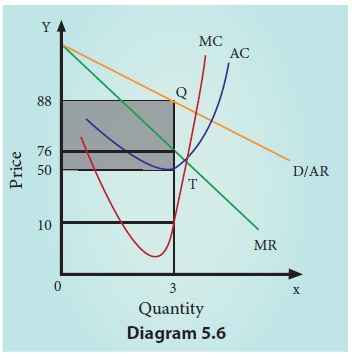Economics - Monopoly | 11th Economics : Chapter 5 : Market Structure and Pricing
Chapter: 11th Economics : Chapter 5 : Market Structure and Pricing
Monopoly
Monopoly
Meaning:
The word
monopoly has been derived from the combination of two words i.e., ‘Mono’ and
‘Poly’. Mono refers to a single and “poly” to seller.
In this
way, monopoly refers to a market situation in which there is only one seller of
a commodity. Hence, there is no scope for competition. (Still some economists
observe that there will always be potential threat to the monopolists).
Definition
Monopoly
is a market structure characterized by a single seller, selling the unique
product with the restriction for a new firm to enter the market. Monopoly is a
form of market where there is a single seller selling a particular commodity
for which there are no close substitutes.

1. Features of Monopoly
1.
There is a single producer / seller of a product;
2.
The product of a monopolist is unique and has no
close substitute;
3.
There is strict barrier for entry of any new firm;
4.
The monopolist is a price-maker;
5.
The monopolist earns maximum profit/ abnormal
profit.
2. Sources of Monopoly Power
1. Natural Monopoly:
Ownership
of the natural raw materials [Eg.Gold mines (Africa), Coal mines, Nickel
(Canada) etc.]
2. State Monopoly:
Single
supplier of some special services (Eg.Railways in India)
3. Legal Monopoly:
A
monopoly firm can get its monopoly power by getting patent rights, trade mark
from the government.
3. Price & Output Determination Under Monopoly
A monopoly is a one firm-industry. Therefore, a firm under monopoly faces a downward sloping demand curve (or AR curve). Since, under monopoly AR falls, as more units of output are sold, the MR lies below the AR curve (MR<AR).

The
monopolist will continue to sell his product as long as his MR>MC.
He
attains equilibrium at the level of output when its MC is equal to MR. Beyond
this point, the producer will experience loss and hence will stop selling.
Let us
take the following hypothetical example of Total Revenue Function and Total
cost function.
TR=100Q-4Q2
and
TC=Q3 -
18Q2 + 91Q +12.
Therefore
AR= 100 - 4Q;
MR=100 -
8Q;
AC= Q2-
18Q + 91 + 12/Q;
MC= 3Q2
- 36Q + 91;
When Q=3,
AR= 100 –
4(3) = 88,
AC= 32-18(3)
+91+12/3= 9-54+91+4=50;
MR=100-8(3)
=76;
MC=
3(3)2- 36(3) +91=27-108+ 91 = 10
From this
diagram, till he sells 3 units output, MR is greater than MC, and when he
exceeds this output level, MR is less than MC. The monopoly firm will be in
equilibrium at the level of output where MR is equal to MC. The price is 88.
To
checkup how much profit the monopolist is making at the equilibrium output, the
average revenue curves and the average cost curves are used. At equilibrium
level of output is 3; the average revenue is 88 and the average cost is 50.
Therefore (88-50 =38) is the profit per unit.
Total
profit = (Average Revenue – Average Cost) X Total output
= (88 –
50) X3
= 38X3=114.
4. Price Discrimination under monopoly
A
discriminating monopoly is a single entity that charges different prices for
different consumers. Higher price will be charged for price inelastic consumers
and vice versa
Types of Price Discrimination
There are
three types of price discrimination.
Personal – Different
prices are charged for different individuals (for example, the railways
give tickets at concessional rate to the ‘senior
citizens’ for the same journey).
Geographical
- Different
prices are charged at different places for the same product (for example, a book
sold within India at a price is sold in a foreign country at lower price). On
their basis, China drops its goods in Indian market. As a result, watch and
toys industries closed down their business.
On the basis of Use -
Different prices are charged according to the use of a product (for example, lower rates are charged
by Tamil Nadu Electricity Board for domestic uses of electricity and higher
rates are charged for commercial and industrial uses).
5. Degrees of Price Discrimination
Price discrimination
has become widespread in almost all monopoly markets.
According
to A.C.Pigou, there are three degrees of price discrimination.
i. First degree price discrimination
A monopolist
charges the maximum price that a buyer is willing to pay. This is called as
perfect price discrimination. This price wipes out the entire consumer’s
surplus. This is maximum exploitation of consumers. Joan Robinson named it as
“Perfect Discriminating Monopoly”
ii. Second degree price discrimination
Under
this degree, buyers are charged prices in such a way that a part of their
consumer’s surplus is taken away by the sellers. This is called as imperfect
price discrimination. Joan Robinson named it as “Imperfect Discriminating
Monopoly”. Under this degree, buyers are divided into different groups and a
different price is charged for each group. For example, in cinema theatres,
prices are charged for same film show from viewers of different classes. In a
theatre the difference between the
first row
of first class and the last row in the second class is smaller as compared to
the differences in charges.
iii. Third degree price discrimination
The
monopolist splits the entire market into a few sub-market and charges different
price in each sub-market. The groups are divided on the basis of age, sex and
location. For example, railways charge lower fares from senior citizens.
Students get discounts in museums, and exhibitions.
6. Dumping
Dumping
refers to practice of the monopolist charging higher price for his product in
the local market and lower price in the foreign market. Through dumping, a
country expands its command over other countries for its product. This is also
called as ‘International Price Discrimination”.
For
example, India’s electronic market is flooded with the China’s products.
Related Topics